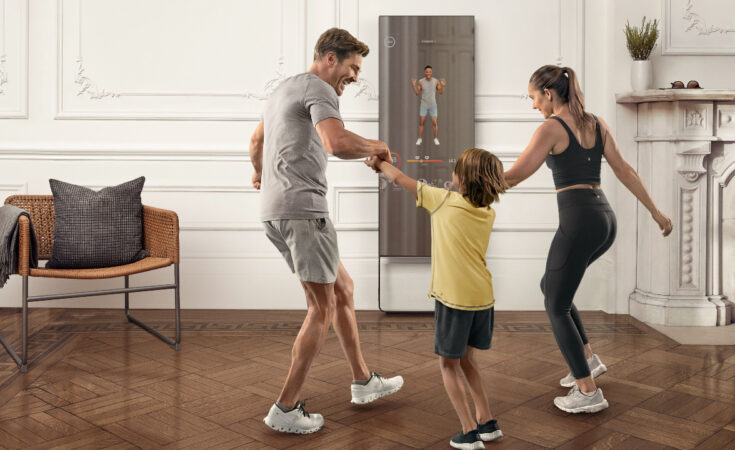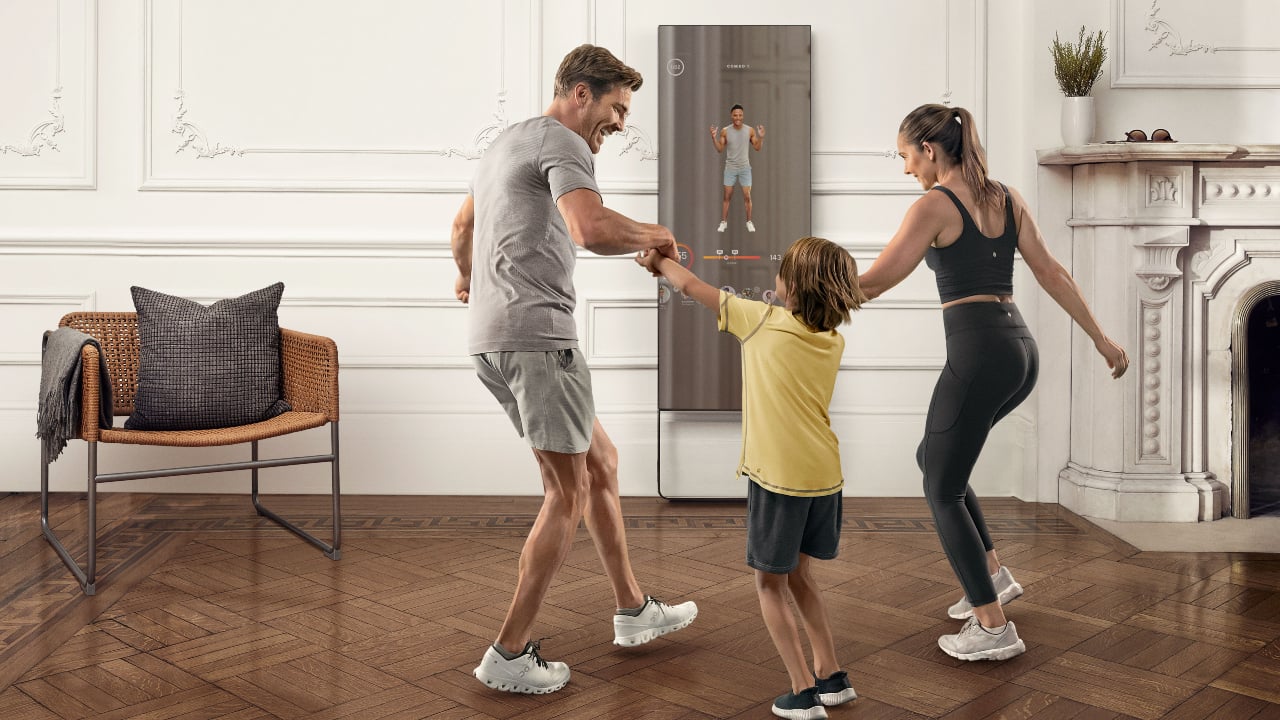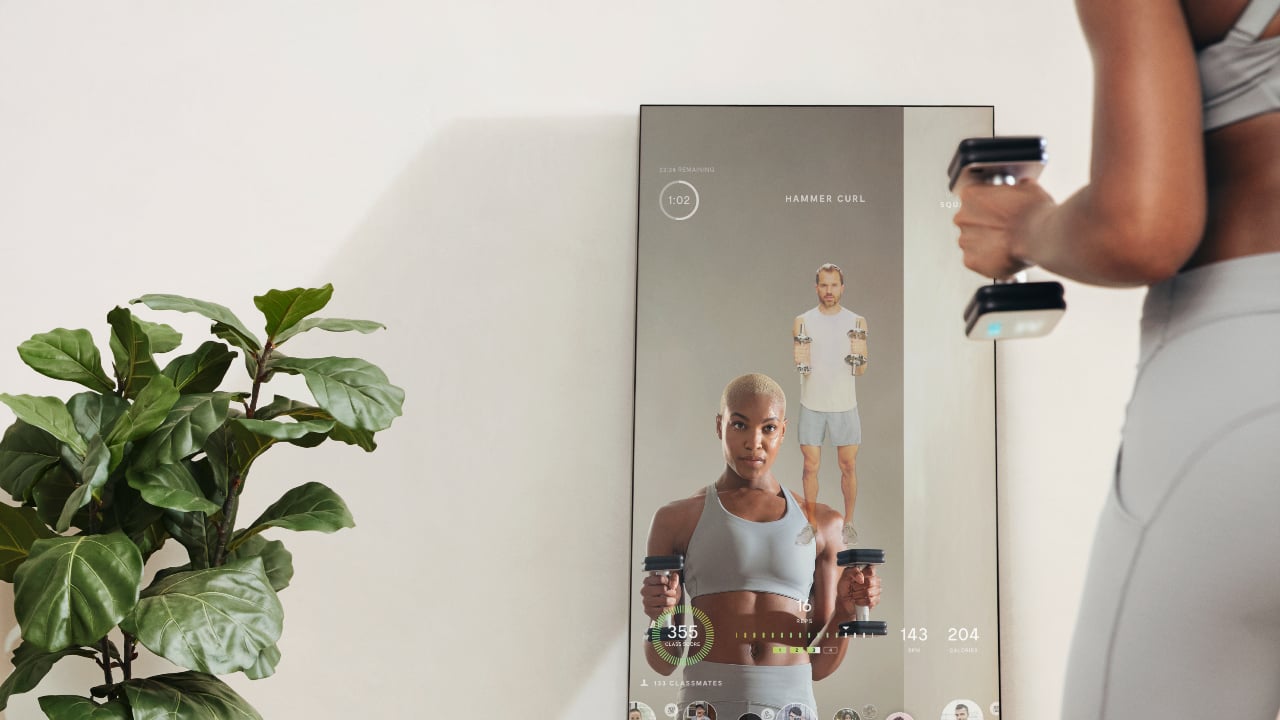“Keep pushing, Simone!”
Gerren’s voice rings out through my back room as our eyes meet in the mirror. I don’t expect it but can’t deny the rush that shoots through my body. For the last eight weeks, I’ve been testing out Mirror from Lululemon and these tiny thrills have (sadly?) become one of the highlights of my days.
Although the world seems to be moving towards reopening, in my world—the one where I live with an infant and five-year-old—house arrest is just a side effect of being a parent.
During the day, I’m a victim to the double nap trap, and in the evenings, attempting to go any further than my couch once the kids have (finally) gone to sleep feels like a big ask. And so I find myself, nap after nap and night after night, meeting up with Gerren (or Lance or Pilin or Patricia) for a 15-minute cardio boot camp, a 30-minute advanced pilates class, 45 minutes of strength training or even a 5-minute meditation. The options feel endless and the convenience is palpable.
Mirror is one of the latest installments in the home gym sphere. Though it’s been on the market since 2018, Lululemon acquired it in July 2020 and brought it to Canada in the fall of 2021.
It was created by Brynn Putman, a formal professional ballerina and creator of a high-intensity interval training program, who just couldn’t manage going to the gym and keeping up with classes while pregnant and suffering with awful morning sickness. She wanted to be able to enjoy a quality workout from home that wasn’t just about convenience. So Putnam tapped into her own experience to brainstorm and bring the best elements of the gym into a home workout. She was pitching to investors at nine-months pregnant and secured her first round of funding on the same day that she gave birth to her son—signing the deal from her hospital suite.
What is Mirror from Lululemon?
Mirror looks just as it sounds—a full-length mirror that can either lean against the wall or be mounted. The sleek carbon steel frame fits snug to the side of the mirror, so it can easily blend into any room regardless of your decor. It definitely doesn’t look like gym equipment, but once you turn it on, a 43-inch screen within the mirror lights up to reveal your instructor—in full length—who will guide you through a class of your choosing. There are built-in speakers and a camera if you want to show off your moves to the instructor or your classmates during a live class, but you can also connect the mirror to cordless headphones and opt to keep your camera set to private.
We set ours up in our backroom, which typically serves as a mudroom leading out to the backyard. Since the mirror leans against the wall, using it only involves making sure shoes and backpacks are moved to accommodate roughly the space of a yoga mat. Post-workout cleanup is as simple as rolling up said mat.
How do you use it?
The Mirror app is your gateway to using your mirror. Here you will set up your profile, connect to your mirror, choose your mirror workouts and control your display and settings. It will also track your progress, what classes you’ve taken, and who your favourite instructors are and will connect you to other users. The Mirror app claims to have more than 10,000 on-demand classes ranging from Tai Chi, yoga and pilates to boot camp, dance and kickboxing. You can also tune in for live classes where you’re likely to get a shoutout from the instructor—the thrill I mentioned above.
Once you’ve settled on your favourite types of classes, you can create shortcuts that filter for the length of class, skill level, instructor, equipment and new content so finding a workout is fast and easy.
How much does Mirror cost?
Like most home gym equipment, Mirror doesn’t come cheap. The base price is $1,895 plus tax and includes the mirror, stand and a standard warranty. Upgraded packages throw in accessories like a heart rate monitor, weights, yoga blocks and tension bands. To access classes, users must also pay a membership fee of $49 a month with a minimum one-year commitment. After 12 months, you can opt for a month-to-month payment plan.
Photo: Lululemon
Pros
For me, having on-demand classes at home was the biggest game-changer. Not only could I tune in whenever I had a 30- or even 5-minute window, but the app made it extremely easy to find a suitable workout quickly without having to scroll through endless options on something like YouTube. I also really liked using the actual mirror to check my alignment or see myself during the class. And when it wasn’t in use, it served as tasteful entryway decor.
It’s funny, but after two years of not stepping foot in a gym, I was surprised by how much I missed that sense of community. Though I rarely turned on my camera, seeing the number of other people working out at the same time as me—as well as the bubbles with images of my classmates—or getting a shoutout from the instructor made me feel accountable. I’m also naturally competitive, so racking up a higher health score (a calculation of your heart rate, strength and recovery points) than my husband was a bonus.
The wide variety of classes also meant that there was something for everyone—even my five-year-old! While I mostly stuck to yoga, pilates and boot camp classes, my husband would do strength classes in the evening and my daughter became addicted to the family fun classes, which include dance, ballet, cardio and yoga. She would often do these while I was making dinner or putting her baby sister to bed. There is also an entire section dedicated to pre- and postnatal workouts with cardio, strength, barre and yoga classes.
Cons
For the equipment-phobic or those living in tight quarters, even finding space for a mirror with room to move in front of it can be a challenge—why not just use your TV? While users can stream Mirror classes on their TV or using a smartphone or tablet (super handy when travelling), you currently must own an actual Mirror and have an active membership to use this feature.
Also, unlike other at-home fitness programs, there are no music-themed classes on Mirror —shoutout to my fellow Encanto Peloton riders. Users have the option to choose between Mirror Music (with pop, rock, dance, hip hop, yoga and meditation playlists) or personal playlists on Apple Music. For most classes, this isn’t a deal-breaker, but I found it challenging to keep the rhythm for things like boxing combinations when they weren’t set to specific music.
Is Mirror worth the hype?
The short answer: Maybe?
Compared to a lot of other at-home equipment on the market, the Mirror is relatively small and easy on the eyes. Monthly membership fees for on-demand services are often the toughest pill to swallow, but considering the wide variety of classes and the ability to have up to five users on a membership, it may be cheaper than any other gym membership out there depending on how much you use it. Also, if you decide after a year you’re not really into it anymore, you still have a pretty decent looking, albeit pricey, mirror for your home instead of a bulky bike or other cumbersome gym equipment collecting dust.
Overall, I’ve been really happy with my Mirror experience. In the last eight weeks, I’ve felt stronger and more motivated to move. I have rediscovered my love for yoga and have expanded my fitness repertoire to include things like pilates, barre and Latin dance, which I probably wouldn’t have otherwise attempted. It’s also been really nice to see the rest of my family get more motivated to move. After the fog of the last two years, having something easy to use in our house feels like a real luxury. And even with gyms opening up, taking a class at home any time you want will always be easier and cheaper than getting a babysitter or working around kids, a career and life.
If the pandemic has had one silver lining, it may be the boom of the home gym. Because even before there was a virus raging through our streets (and gyms), there were parents stuck at home trying to get in a sweat.
Stay in touch
Subscribe to Today’s Parent’s daily newsletter for our best parenting news, tips, essays and recipes.
= 0;if(!is_postback){return;}var form_content = jQuery(this).contents().find(‘#gform_wrapper_13’);var is_confirmation = jQuery(this).contents().find(‘#gform_confirmation_wrapper_13’).length > 0;var is_redirect = contents.indexOf(‘gformRedirect(){‘) >= 0;var is_form = form_content.length > 0 && ! is_redirect && ! is_confirmation;var mt = parseInt(jQuery(‘html’).css(‘margin-top’), 10) + parseInt(jQuery(‘body’).css(‘margin-top’), 10) + 100;if(is_form){jQuery(‘#gform_wrapper_13’).html(form_content.html());if(form_content.hasClass(‘gform_validation_error’)){jQuery(‘#gform_wrapper_13’).addClass(‘gform_validation_error’);} else {jQuery(‘#gform_wrapper_13’).removeClass(‘gform_validation_error’);}setTimeout( function() { /* delay the scroll by 50 milliseconds to fix a bug in chrome */ jQuery(document).scrollTop(jQuery(‘#gform_wrapper_13’).offset().top – mt); }, 50 );if(window[‘gformInitDatepicker’]) {gformInitDatepicker();}if(window[‘gformInitPriceFields’]) {gformInitPriceFields();}var current_page = jQuery(‘#gform_source_page_number_13’).val();gformInitSpinner( 13, ‘https://www.todaysparent.com/wp-content/plugins/gravityforms/images/spinner.gif’ );jQuery(document).trigger(‘gform_page_loaded’, [13, current_page]);window[‘gf_submitting_13’] = false;}else if(!is_redirect){var confirmation_content = jQuery(this).contents().find(‘.GF_AJAX_POSTBACK’).html();if(!confirmation_content){confirmation_content = contents;}setTimeout(function(){jQuery(‘#gform_wrapper_13’).replaceWith(confirmation_content);jQuery(document).scrollTop(jQuery(‘#gf_13’).offset().top – mt);jQuery(document).trigger(‘gform_confirmation_loaded’, [13]);window[‘gf_submitting_13’] = false;}, 50);}else{jQuery(‘#gform_13’).append(contents);if(window[‘gformRedirect’]) {gformRedirect();}}jQuery(document).trigger(‘gform_post_render’, [13, current_page]);} );} );]]>
Read The Full Article Here




































